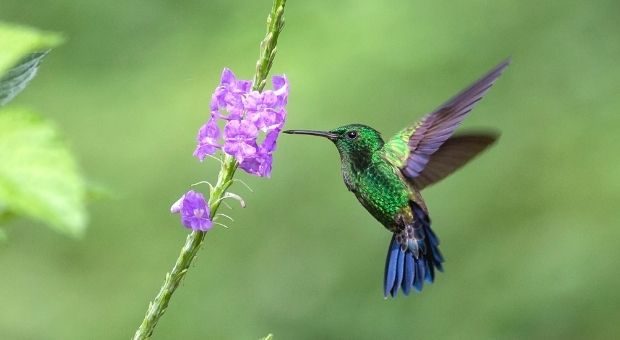29
Mar
Suspension of Deadly Insecticide Use and Transition to Organic Needed to Save Hummingbirds

(Beyond Pesticides, March 29, 2021) New data on the hazards of neonicotinoid insecticides calls for urgent regulatory action. The same pesticides that are linked to the worldwide decline of insect pollinators also present significant risks to their avian counterparts, hummingbirds. Widely known for their nectar-fueled hovering flight powered by wings beating up to 80 times per second, hummingbirds display unique reactions to toxic pesticides. Research by scientists at the University of Toronto finds that hummingbirds exposed to systemic neonicotinoid insecticides for even a short period of time can disrupt the high-powered metabolism of this important and charismatic animal.
While hovering, a hummingbird consumes calories faster than any other bird or mammal. That’s why the finding that exposure to the neonicotinoid insecticide imidacloprid slows metabolism up to 25% is so disturbing. Systemic pesticides like imidacloprid and other neonics are transported throughout the plant, including nectar.
Findings on the danger neonicotinoids pose to hummingbirds decades after the chemicals were first permitted to be used in the environment, and by independent scientists, not regulatory agencies, is indicative of a regulatory approach that fails to embrace precaution from the outset. Overwhelming data has already been established on the threat neonicotinoids pose to the health of ecosystems worldwide. The list of animals found to be adversely affected by neonicotinoids is extensive, ranging from humans and other mammals, to insect pollinators, songbirds, amphibians, and other aquatic species.
Of the 338 species of hummingbirds—all found in the Western hemisphere—34 are already endangered. We need to remove this threat to these amazing little birds by replacing chemical-intensive agriculture and horticulture with organic practices.
To help hummingbirds:
- Tell the Biden administration and Congress to halt all new pesticide registrations until science is restored to its rightful place in EPA decision-making.
- Plant an organic garden with nectar-producing flowers.
Tell EPA and Congress to save the hummingbirds.
Letter to Michael Regan, Administrator, EPA
New data on the hazards of neonicotinoid insecticides calls for urgent regulatory action. The same pesticides that are linked to the worldwide decline of insect pollinators also present significant risks to their avian counterparts, hummingbirds. Widely known for their nectar-fueled hovering flight powered by wings beating up to 80 times per second, hummingbirds display unique reactions to toxic pesticides. Research by scientists at the University of Toronto finds that hummingbirds exposed to systemic neonicotinoid insecticides for even a short period of time can disrupt the high-powered metabolism of this important and charismatic animal.
While hovering, a hummingbird consumes calories faster than any other bird or mammal. That’s why the finding that exposure to the neonicotinoid insecticide imidacloprid slows metabolism up to 25% is so disturbing. Systemic pesticides like imidacloprid and other neonics are transported throughout the plant, including nectar.
The failure of EPA to act on Independent scientific findings on the danger that neonicotinoids pose to hummingbirds is indicative of clearly inadequate protection of ecosystems critical to our future. Overwhelming data has already been established on the threat neonicotinoids pose to the health of ecosystems worldwide. The list of animals found to be adversely affected by neonicotinoids is extensive, ranging from humans and other mammals, to insect pollinators, songbirds, amphibians, and other aquatic species.
Of the 338 species of hummingbirds—all found in the Western hemisphere—34 are already endangered. We need to remove this threat to these amazing little birds by supporting and incentivizing the transition from chemical-intensive agriculture and horticulture to organic practices.
Please address these threats to hummingbirds by suspending neonicotinoid insecticides. Eliminate pesticides that endanger pollinators and their habitat.
Thank you.
Letter to U.S. Congress
New data on neonicotinoid insecticides calls for urgent regulatory action. The same pesticides that are linked to the worldwide decline of insect pollinators also present significant risks to their avian counterparts, hummingbirds. Widely known for their nectar-fueled hovering flight powered by wings beating up to 80 times per second, hummingbirds display unique reactions to toxic pesticides. Research by scientists at the University of Toronto finds that hummingbirds exposed to systemic neonicotinoid insecticides for even a short period of time can disrupt the high-powered metabolism of this important and charismatic animal.
While hovering, a hummingbird consumes calories faster than any other bird or mammal. That’s why the finding that exposure to the neonicotinoid insecticide imidacloprid slows metabolism up to 25% is so disturbing. Systemic pesticides like imidacloprid and other neonics are transported throughout the plant, including nectar.
The failure of EPA to act on Independent scientific findings on the danger that neonicotinoids pose to hummingbirds is indicative of clearly inadequate protection of ecosystems critical to our future. Overwhelming data has already been established on the threat neonicotinoids pose to the health of ecosystems worldwide. The list of animals found to be adversely affected by neonicotinoids is extensive, ranging from humans and other mammals, to insect pollinators, songbirds, amphibians, and other aquatic species.
Of the 338 species of hummingbirds—all found in the Western hemisphere—34 are already endangered. We need to remove this threat to these amazing little birds by supporting and incentivizing the transition from chemical-intensive agriculture and horticulture to organic practices.
Please ask EPA to address these threats to hummingbirds by suspending neonicotinoid insecticides. Eliminate pesticides that endanger pollinators and their habitat.
Thank you.










